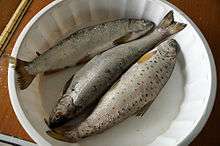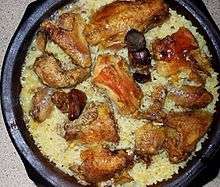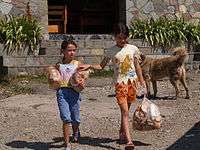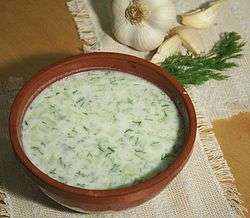Albanian cuisine

Albanian cuisine on the Sofra
Albanian cuisine (Albanian: Kuzhina shqiptare) is the national cuisine of the Albanian people. It is Mediterranean, influenced by many including Greek, Italian and Turkish cooking.
Albanian cuisine is characterized by the use of Mediterranean herbs such as oregano, mint, basil, rosemary and more in cooking meat and fish, but also chilli pepper and garlic.
Vegetables are used in almost every dish.
The main meal of the Albanians is lunch, which usually consists of gjellë (stew), the main dish of slowly cooked meat with various vegetables, and a salad of fresh vegetables, such as tomatoes, cucumbers, green peppers, and olives. The salad is dressed with salt, olive oil, vinegar or lemon juice.
In high elevation localities, smoked meat and pickled preserves are common. Animal organs are also used in dishes such as intestines and the head among other parts, which are considered a delicacy. Dairy products are integral part of the cuisine usually accompanied with ever present bread and alcoholic beverages such as Raki. Seafood specialties are also common in the coastal cities such as Durrës, Vlorë, Shkodër, Lezhë and Sarandë.
Appetizers
Corn bread and pogace bread (left), Buying bread in Albania (right).
- Wheat Bread (Bukë gruri) or corn bread (Bukë misri) are ever-present on the Albanian table. Hence the expression for "going to eat a meal" (Albanian: për të ngrënë bukë) can be literally translated as "going to eat bread." 'Bread' is also used in the authentic Albanian hospitality saying of "bread, salt, and heart" (Alb.: bukë, kripë e zemër).
- Chicken livers
- Eggplant appetizers
- Dollma
- Panaret, famous among Arbereshe
- Stuffed Peppers (green peppers stuffed with rice, meat, other vegetables and herbs)
- Pickled cabbage (Turshi lakre)
- Fried sardines with lemon (sardele me Limon)
- Albanian-style meze platters that include prosciutto ham, salami and feta cheese, accompanied with roasted bell peppers (capsicum) or green olives marinated in olive oil with garlic or onions.
- Papare: bread leftovers cooked with water, egg, butter, and Gjize (salted curd cheese)
Salads

Farmers' market early in the morning, Tirana
Soups
Fish

Ohrid Trouts
Meat

Traditional dish from Hasi Region

Roasted lamb on a rack
- Tavë kosi, baked lamb and yogurt dish
- veal or chicken with walnuts[1]
- Fërgesë of Tirana with veal (also see sataraš)
- Fried meatballs or Qofte të fërguara.
- Proshute a dry-cured ham
- gjiri gic a roasted pig
- Kolloface Korçe
- Veal with very large lima beans
- Harapash, polenta with the intestines of lamb, butter, cheese and corn flour
- Paçe - common throughout the country and it is traditionally popular in Albania. Paçe is made with a sheep's, pig's or any cattle's head, boiled until meat comes off easily. It is then stewed with garlic, onion, black pepper, and vinegar. Sometimes a little flour is added to thicken the stew. It makes a hot and hearty winter stew.
Vegetables
Pies

Byrek in Albania accompanied with Dhalle

Qervish
- Byrek — Albanian vegetable pie; it can also have feta cheese, spinach, cabbage, tomatoes, or meat; it's a layered pie made with filo pastry. Another version of the fillings is served as a filling for "pite" or "pita".
- Kungullur — Pastry layers filled with mashed pumpkin, butter, salt or sugar
- Bakllasarëm — A traditional food prepared in Kosovo and Albania: it's layered pie also known as "pite" or "pita" (Byrek) without anything inside, which is covered with yogurt and garlic, and then heated again. It is eaten for lunch.
- Flia — A traditional food prepared in Kosovo and Albania.
- Qumeshtore
- Pepeq
- Shaprak
- Qollopita
- Lakruar is similar to burek however, it has layers of filo dough with onion, olive oil, eggs. It is specialty of South regions in Lunxheri
Desserts

Baklava is prepared on large trays and cut into a variety of shapes
Patisseries are present in every Albanian city. The most common desserts in Albania are made throughout the Balkans:
Drinks
Mineral water is one of the most preferred non-alcoholic drinks in Albania, along with carbonated beverages. Some of these are produced locally and some are imported.
See also
References
Further reading
 |
Wikibooks Cookbook has a recipe/module on
|
|
|---|
| | Northern Africa | |
|---|
| | Southern Europe | |
|---|
| | European regions | |
|---|
| | Western Asia | |
|---|
|












